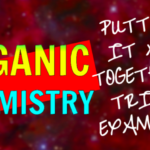In today’s lesson, we will use what we previously learned in this chapter to put together names and drawings of trickier organic compounds. Here’s what we learned so far (if you are not up to date with all of these, please check out the previous blog posts before heading to this one):
(a) Drawing Skeletal Structures
https://www.petwantsclt.com/petwants-charlotte-ingredients/ (b) Using Organic Naming Prefixes
(c) Nomenclature of Functional Families: Alkanes, Alkenes, Alkynes, Cycloalkanes, Benzene, Carboxylic Acids, Alcohols, Thiols, Ethers, Thioethers, Esters, Amines, Amides, Heterocyclics, Bridgeheads, Aldehydes, Ketones, Diketenes, Dialdehydes, Cyclic Ketones, Ketenes, Nitriles, Anhydrides, and Acyl Halides
https://www.petwantsclt.com/petwants-charlotte-ingredients/ (d) Cis/Trans Naming of Alkenes
(e) Nomenclature Rules and Exceptions
https://www.merlinsilk.com/neologism/ (f) Naming of Substituents
VIDEO WILL GO HERE! WILL BE UP SOON!
We are going to be doing trickier examples that encompass all of these rules, including understanding the priority of naming functional groups when there are more than one in the same shape.
Priority of Groups (picture taken from this link)

Example 1 – Trickier Alkenes. This is tricky because the shape is more complex than what we usually see, and there are two double bonds in the same shape.






Now numbering the carbon chain, we need to number through both double bonds (which means both carbons in each double bond need to be numbered in the main chain). The main chain is in yellow. The way I numbered it gives the lowest possible numbers to both of the double bonds (it’s just guess and check, start from one end and figure out whether it will give the lowest number. There’s only so many ends you can start from). Anything highlighted in blue is a substituent (not a part of the main chain so it must be named separately).
The prefix of the main chain is “undeca” for 11 carbons (keeping the ‘a’ when we don’t have the ending starting with a vowel. Because instead of ‘ene’ it’s ‘diene’), and we need to use “diene” at the end because we have two double bonds in the shape. Now number the carbons in the double bond, noting whether they are E or Z next to the numbers. This gives 3Z, 6E, because on the double bond on carbon 3 it’s a Z, and the double bond in carbon 6 is an E.


Example 2 – Many substituents mixed with two different families
E-4,4-dicholoro-6-isopropyl-5,7,8-trinitrodec-2-en-1-ol
To draw this shape, we first identify what two functional groups are in the shape. The end of the chain has “en” and “ol” and the numbers that they’re on.
Then we identify how many carbons are in the main chain. This has the prefix “dec” in it, so it’s ten.
Let’s draw a 10 carbon chain and number it:

Add in the double bond and the alcohol. We know they’re in there because the end of the shape says “en” and “ol,” which signify “alkene” and “alcohol.” These are on the carbon 2 and 1, respectively. The double bond is also an ‘E’, which means the bonds are going in opposite directions (this is the usual zig-zag chain). This ‘E’ is at the beginning of the name to indicate it.

Add in all the substituents on their respective carbons. We have 2 chlorines, 3 NO2 groups, and an isopropyl.

Once I remove the numbers to clean it up, it looks like this:

Example 3 – More than one ring within a shape/mixed rings and chains within same shape

The first step here is to figure out whether one specific chain OR the entire ring has more carbons. This is a 6 carbon ring, and neither of the carbon chains coming out of it have more than 6 carbons (and we don’t count from chain into ring or vice versa. Count ONLY the straight chain carbons OR the ring carbons). Since the 6 carbon ring has the highest number of carbons, we number it to give all the substituents the lowest numbering:

The main chain is a cyclohexane because it’s a 6 carbon ring. The prefix for 6 is “hex” and putting it into the cycloalkane name is cyclohexane. I numbered it starting from the bottom right because the longest substituent will be on carbon 1.
Now let’s name the substituent chains, each numbered in green. The first carbon out of the ring on each substituent is carbon 1.
On carbon 4, we have 1 carbon but with a cyclobutane coming out of it. This substituent is a methyl, but with a 1-cyclobutyl. So 1-cyclobutylmethyl. On carbon 1, we have 3 carbons, so it’s a propyl. Off of carbon 3 on that propyl chain, there’s a cyclopropyl group. That’s 3-cyclopropylpropyl. Putting these together in alphabetical order (prioritized under the bolded letters m and p) we get:
1-cyclobutylmethyl-3-cyclopropylpropylcyclohexane
Example 4 – Multiple branched chains

To name this, we should first figure out the longest carbon chain – this is just done through trial and error. I have numbered the longest chain and highlighted it in yellow, then highlighted the substituents in blue: We have a 12 carbon chain, and we haven’t discussed past 10 carbon prefixes in previous lessons. However, just so you’re aware – “undec-” is the prefix for 11, and “dodec-” is the prefix for 12 carbons.
We don’t have any other functional families here, so it’s only alkanes. This makes it a “dodecane.” Let’s name all the substituents with their numbers: 3-methyl, 4-methyl, 5-ethyl, 6-methyl, 9-methyl. Putting these together at the beginning of the name, we get 5-ethyl-3,4,6,9-tetramethyldodecane.

